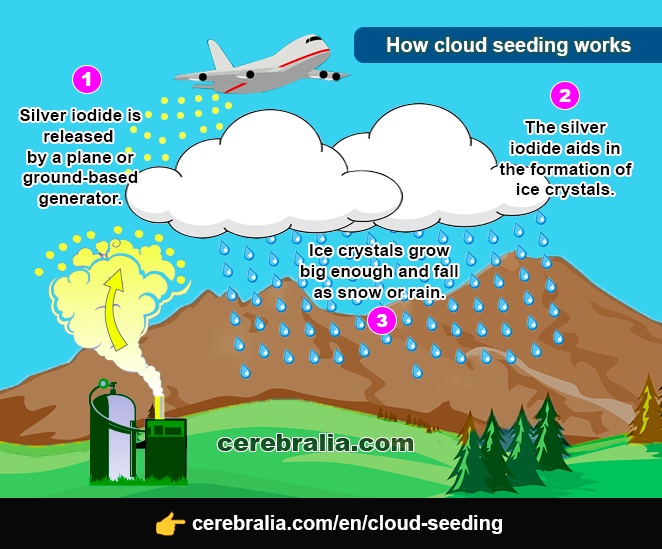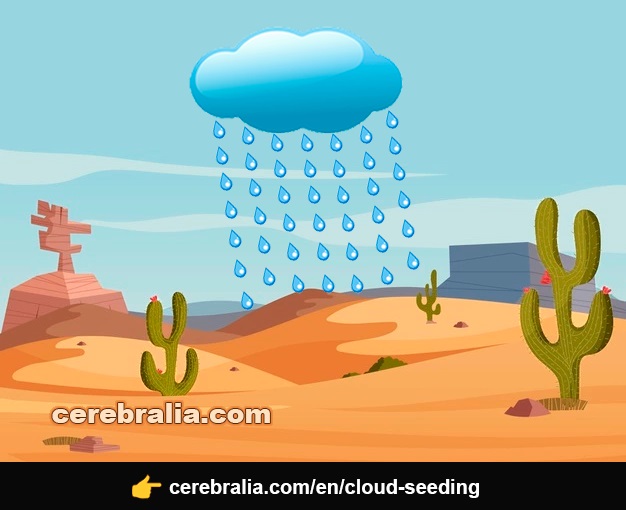Share on:
Cloud seeding
Cloud seeding is a process that utilizes chemicals that are freed into the environment to amplify the water amount in the air in order to increase the chance of precipitation. It is one type of weather modification.
Despite its popularity as a tool to cope with the lack of water shortages resulting from droughts and snow droughts, especially across the western United States, though, the questions and controversy surrounding its efficacy and ethics remain hotly debated.

How It Works
In nature, supercooled water vapour molecules in the clouds condense around specs of dust or salt, known as condensation nuclei. Then, the condensed water vapour droplets group together. This process continues until the droplets are large enough to fall as rain.
Cloud seeding boosts this natural process by injecting clouds with additional condensation nuclei, thus enhancing the number of droplets that grow large enough to fall as raindrops or snowflakes, depending on air temperatures within and beneath the cloud.
These «man-made» nuclei come in the form of chemicals like silver iodide (AgI), sodium chloride (NaCl), and dry ice (solid CO2). Liquid propane has also been used due to its ability to change form liquid to gas. They aid in cloud condensation and changing the microphysical procedures that take place within the cloud.
There are different ways of adding these particles to clouds:
- By dispersion devices located on the ground (generators fired from cannons or rockets) that shoot particles into the sky.
- Using airplanes that drop the particles from above.
But, Does It Work?
Whether cloud seeding is effective in producing a statistically significant increase in precipitation is still a matter of academic debate, with contrasting opinion among experts.
In 2003 the US National Research Council released a report stating, «In the 55 years following the first cloud-seeding demonstrations, substantial progress has been made in understanding the natural processes that account for our daily weather. Yet scientifically acceptable proof for significant seeding effects has not been achieved».
A 2010 Tel Aviv University study claimed that the common practice of cloud seeding to improve rainfall, with materials such as silver iodide and frozen carbon dioxide, seems to have little if any impact on the amount of precipitation.

Jeff Tilley, director of weather modification at the Desert Research Institute in Reno, claimed in 2016 that new technology and research has produced reliable results that make cloud seeding a dependable and affordable water supply practice for many regions.
Moreover, in 1998 the American Meteorological Society held that «precipitation from supercooled orographic clouds (clouds that develop over mountains) has been seasonally increased by about 10%».
The complex nature of clouds has so far thwarted attempts to develop quantitative forecasts of rainfall of sufficient accuracy to be used to evaluate a cloud-seeding scheme. Also, as is well known, precipitation is highly variable in space and time. As a result, it is not possible, on the basis of a physical theory, to answer satisfactorily the question.
Impact on environment and health
Cloud seeding requires the use of chemicals, some of which are potentially harmful to the natural environment. Furthermore, there has been no clear study into the effects of silver iodide on the environment thereby putting people at great risk.
The chemicals produced during cloud seeding are present in the water and soil deposits of the area where it has been practiced. The more animals and plants are exposed to it, the more they are at risk of developing health issues.

If exposed to a higher level one could develop permanent skin problems like argyria. There is no set standard for the amount of silver one can come into contact with, which even makes the impact riskier as they are unknown.
All in all, extensive research should be carried out in order to fully understand the long term implications that come with cloud seeding. It is not a well-focused on an area of study which makes it rather difficult to grasp every aspect of it.
